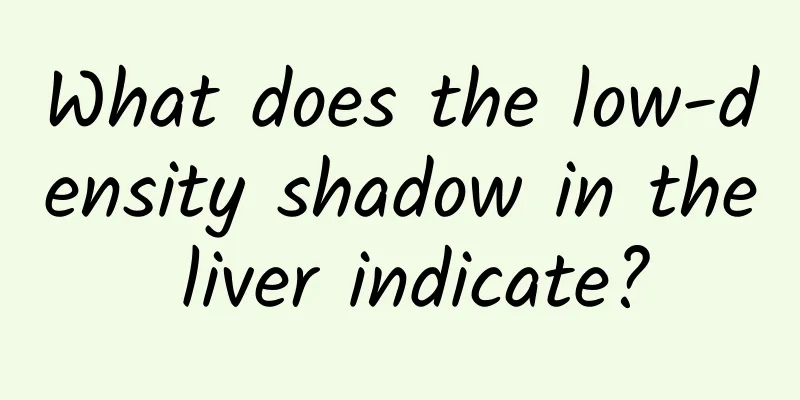What does the low-density shadow in the liver indicate?

|
During a CT scan, if the liver is healthy, the density of the liver is uniform. If there is a lesion, the density, structure and morphology of the liver will change. These changes have certain characteristics. For example, if a low-density shadow appears in the liver, it may be a tumor, a cyst, or some other lesion. At this time, an enhanced scan or other examinations can be performed. What causes liver cysts? What causes liver cysts? What are the causes of liver cysts? Many people are unfamiliar with the term liver cysts, but for patients with liver disease, liver cysts are one of the symptoms of liver disease and need to be understood. Some patients are afraid that the disease will become more and more serious. Liver disease experts point out that liver cysts are a benign liver disease with many causes: most patients with liver cysts have mild symptoms, with occasional discoveries of painless masses in the upper abdomen, or symptoms such as liver pain, loss of appetite, nausea, and vomiting. Causes of liver cysts - congenital liver cysts: due to developmental disorders of the intrahepatic bile duct and lymphatic vessels during the embryo, or cholangitis during the fetal period, small intrahepatic bile duct occlusion, proximal cystic enlargement and intrahepatic bile duct degeneration, local hyperplasia and obstruction, usually multiple. Causes of liver cysts - retention liver cysts: It is caused by increased secretion of a bile duct in the liver due to inflammation, edema, scar or stone obstruction, or bile retention. It is mostly single, but can also be caused by blunt trauma to the liver, leading to the late stage of central rupture. The lesion cyst is filled with blood or bile, and the capsule is fibrous tissue. It is a single pseudocyst. How to treat liver cysts Generally speaking, patients do not have any special symptoms, but a small number of patients feel abdominal discomfort or pain, which may be due to the superficial location of the cyst and easy friction with the diaphragm or peritoneum. There are many treatments for liver cysts. Today we will mainly introduce the following three surgical treatments. Surgical treatment method for liver cysts 1: Interventional treatment The first surgical treatment I would like to introduce to you is interventional treatment, which refers to repeatedly injecting vascular sclerosant into the cyst cavity to destroy the endothelium of the cyst cavity after draining the cyst fluid under ultrasound or CT. This will make the cyst endothelial cells no longer secrete fluid, thereby achieving the purpose of eliminating the cyst. For infected cysts, after the cyst fluid is drained, it is repeatedly rinsed with saline containing antibiotics. If necessary, drainage is placed and anti-infection, supportive and other treatments are combined. The cyst cavity gradually shrinks, and good short-term results can be achieved. Because this therapy is effective and has little impact on the whole body, it can also be used for elderly and frail patients. The second surgical treatment method for liver cysts: laparoscopic cyst fenestration. Part of the cyst wall is removed under laparoscopy, and the cystic fluid is sucked out to open the cystic cavity to the abdominal cavity. This operation is called cyst fenestration or nuchal removal, which is suitable for general cysts. For patients with concurrent infection, intracystic bleeding or cystic fluid stained with bile, drainage can be placed or puncture and catheter drainage can be performed after fenestration. It uses minimally invasive technology to achieve the purpose of open surgery, allowing the fluid in the cyst to flow into the abdominal cavity and be absorbed by the peritoneum, thereby eliminating the cyst. This method is the most thorough and is currently the most frequently used method.The third surgical treatment method for liver cysts: laparoscopic cystectomy is for patients with obvious symptoms and huge liver cysts. Because the cyst compression has caused atrophy and fibrosis of the liver lobe, the atrophied liver lobe can be removed together with the cyst. In addition, patients with localized liver cysts with complications, such as intracystic bleeding, bile leakage, chronic infection, and malignant transformation, should undergo cyst resection. |
<<: What is thyroid hypodensity?
>>: Is it serious to have low-density shadows in the liver?
Recommend
Very bad breath
Some people will find that bad breath is a proble...
Eye exercises for myopia treatment
Myopia bothers many people. Although there are ma...
Urethra bifurcation after circumcision
Foreskin is too long is a problem that many men h...
Can methylphenidate completely cure it?
Hypothyroidism is a common disease. It is complet...
What are the symptoms of formaldehyde poisoning in children?
Formaldehyde is a toxic substance that is widely ...
What is the cause of white dandruff on the legs?
White dandruff on the legs is mostly caused by a ...
How to cook giant salamander best?
In life, everyone knows that the giant salamander...
What is the function of hot salt compress?
As for hot compress, I believe most of us have us...
What is the reason for heavy menstrual flow?
There are many reasons for heavy menstrual flow, ...
What are the ways to cook velvet antler?
Deer antler has many health benefits, and the way...
What causes sudden tinnitus? Three reasons you must know
In clinical practice, sudden deafness is a common...
Causes of elevated cholesterase
Cholesterol lipase is a glycoprotein that can par...
What should I do if body odor gets worse during pregnancy?
During pregnancy, a woman's body metabolism i...
Coffee and oatmeal weight loss method, the benefits of black coffee you don’t know
We all know that coffee has a refreshing effect. ...
What to do if the corners of your mouth repeatedly develop blisters, swelling, and scars
We often see people getting blisters, redness, sw...









